|
 
On April 13th 1900, two light railway orders
were awarded to the newly formed Glenthorne Harbour Authority, granting
powers to build a branch line to the port (Glenthorne Railway No.1) and a
second branch from Wootton Courtenay to Porlock
West (Glenthorne Railway No.2). From the outset, the Glenthorne Authority
enjoyed running rights on the main line between the two branches.
Despite being inextricably entwined with the
main line, the branches have never became part of the Barnstaple and Minehead
Railway, being operated independently by the Harbour Authority. In later
years, however, they have become the 'tail that wags the dog' as much of the
main line goods traffic originates from it.
Joint running rights for goods traffic (not
passenger) were
granted over the entire main line when grouping took place.
The branch to the harbour begins at County Gate station and is
steeply graded and spectacular, with eight tunnels, one being 1500 yards
long, and winding down along the hillside to Countisbury Point before looping
round and emerging onto the sea cliffs, hanging on a narrow ledge during the
descent to the harbour.
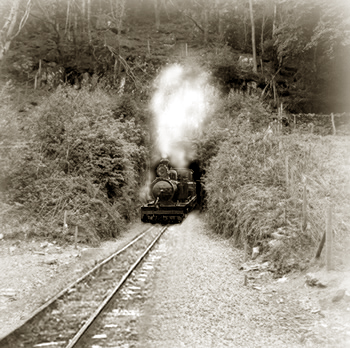
The Kitson Meyer bursts out
from the long tunnel with a heavy train of coal for Porlock.
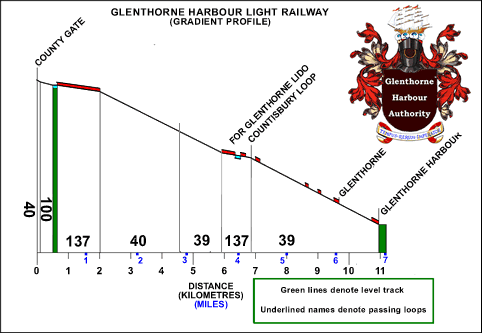
harbour branch gradient profile
The harbour has become a considerable success, increasing freight traffic
both to Minehead and Barnstaple. An elegant harbour office (the main
administrative centre for both branches) and several
substantial warehouses are provided.
The harbour has developed an
active fishing fleet under the name of the 'Glenthorne Fisheries
Co-operative' and a fish van regularly plies between the harbour and the
main line.
Engine shedding for the harbour branch is at County Gate station where
running maintenance takes place. Some major maintenance work is undertaken by
contract at Pilton Yard but Glenlyn yard has gradually increased its
capability to undertake heavy repairs. A carriage shed, engine shed and storage sidings were built a short
distance down the harbour line and enjoy the romantic name of Doone
Sidings. Access to Doone Sidings is by a key on the train staff.
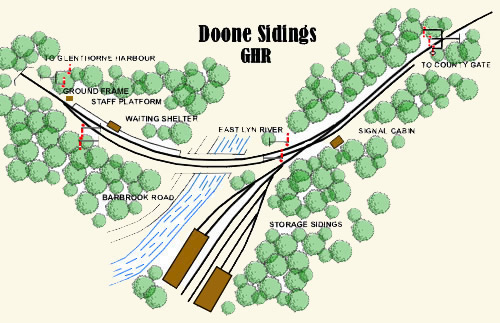

An unusual instance of a main
line locomotive (Exe) operating on the Harbour Branch. Seen here crossing the
the bridge at Doone Sidings. Thought to be a special working from Barnstaple
to connect with a steamer for a day's outing.
A small shed was built at the harbour for
the bottom shunter alongside a large sand oven which also provided sand for
the main line.
A platform was provided for passenger
traffic to the harbour. An anticipated steam packet service to South Wales
never materialised however and poor returns soon resulted in the end of
passenger services (except for daily workmen’s trains) in 1914.
The track layout at County Gate was changed
during the 1932 winter season as the re-instated harbour passenger traffic has been
rapidly increasing. There is now a direct line from the harbour to the bay
platform at County Gate. This has much simplified operations.
The Harbour Authority has recently begun to
change their signalling to modern colour lights.
As goods traffic increased, the Glenthorne Estate
decided that future development should take place much further away from their newly
built hotel. As a result, a new goods depot was built called Glenthorne
Sidings, some mile further down the main line towards Minehead. The goods shed at County Gate
has been sold to the Glenthorne Harbour Authority for their own use.
During the Great War, the
buildings at Glenthorne were requisitioned for war work. They were left in
poor condition and work is still progressing to restore them to their former
purpose.
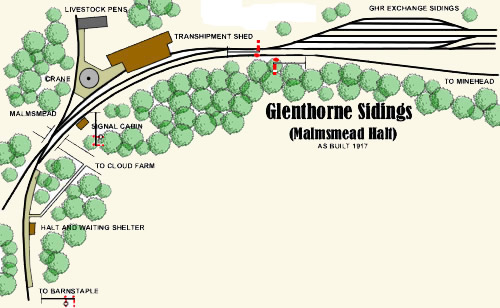
Coal is the mainstay of the harbour. A continual flow is needed for the Porlock power station and the coal merchants, Westmacotte, account for a
considerable tonnage too. This has resulted in private owner wagons travelling on
the L&B main line.
The coal dock is provided with a steam crane with grab bucket and often,
coal is transhipped directly into the coal trains.
After an accident at the harbour in 1926, when a rock fall resulted in a
serious derailment and injury, the Authority built a concrete avalanche shelter at
the entrance to the first tunnel. Rock shelters were also built at several
sections of track along the cliff face. At about the same time, the track layout at the harbour was revised.
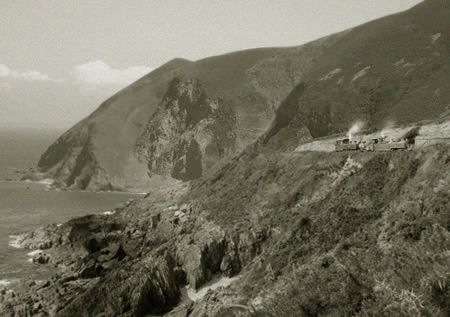
A
Glenthorne train (double headed with 'Ben Halliday and No. 1 or 2)
descending to the harbour
circa 1920.
A new loco shed was built by the Harbour Authority in 1928 at County Gate,
alongside the original stone structure. This permits more demanding
maintenance to be undertaken 'in house' rather than paying the rising costs
charged by the Southern for maintenance at Pilton or Glenlyn.
Road access to Glenthorne Harbour has been been much improved and some
goods are now being being shipped by road. This has resulted in the loss of
some traffic to the railway. South West Lubricants have operated
their own lorry fleet since 1928. In 1934, part of the main warehouse was leased
by the Royal Navy. Many large cases have been brought in by road and ship but what
they contain remains a mystery!
The scenic splendour of the Harbour branch
has not been lost to the directors
and a summer passenger service to the harbour was re-instated in 1928. This service is extremely popular and
a tea room is provided on the ground floor of the Harbour Authority
offices.

The Glenthorne Branch had
spectacular views from the sea cliff - photo Glenthorne
Estate

The long
Countisbury loop is situated on a level stretch of the cliff
section of the railway.
Not to be outdone by the excesses of the Newnes family, in 1929,
Halliday installed a cliff railway to the shore. Access is facilitated by a narrow road on the cliff top and by an
intermediate stop at the railway loop.

A fine modern lido designed
by Mr R.W.H. Jones has been
constructed on the shore. The Glenthorne Lido, as
the facility is known has become a fashionable bathing spot in recent years.
The filtered sea water pool is one hundred and ten feet long and admission
is 6d which includes passage on the cliff railway. The lido has an excellent
restaurant.

click on image to
enlarge
__________________________________________
County Gate and Wootton Courtenay are the busiest intermediate stations on the entire railway
system. A platform in concrete has been re-instated at
County Gate at the former New Siding and the Harbour Authority has built a
'Pagoda Style' shelter at the station and a smaller version down at the
harbour. These are much appreciated during inclement weather. As no loop
is at present available for running round at the harbour two coaches have
been
rebuilt as push pull units. The steam locomotive is
always positioned at the downhill end.
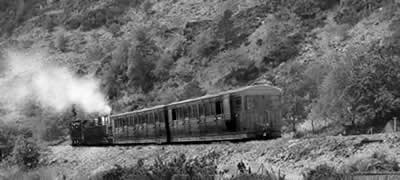
An ex WD Baldwin pushes
the train up the cliff side.
Since the main line has begun its conversion to
railcar operation for much of its service, so the Harbour Authority
has ordered its own diesel power car replace steam traction in its push pull consist. This
has been built locally and employs two Gardner engines using mechanical
gearboxes to the axles. An advanced air operated system is employed to
control the power car from the push pull units. So far, it is not as
reliable as its main line counterparts and it is not
uncommon to see a steam loco being hurriedly prepared along with the push
pull coaches!
The Harbour railcar is painted in a livery very similar to that of the
original Lynton and Barnstaple railway. In 1935, the GHA has purchased the two
prototype railcars from the main line. This has much eased the motive power
situation.
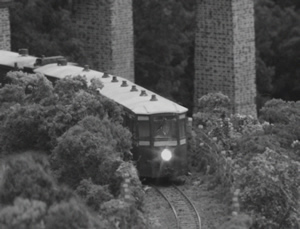
The Glenthorne built
railcar passes under the East Lyn Viaduct and climbs up to County Gate.
The harbour branch was originally elaborately
signalled, however, in recent years, there has been some simplification.
The branch is divided into two sections; County Gate to Countisbury Loop
and Countisbury Loop to Harbour. The sections are controlled by
miniature electric train staff. Some semaphore signals have now been
replaced with colour lights.

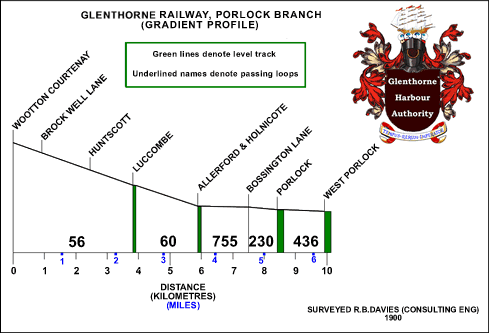
Porlock branch
gradient profile
The Porlock Branch runs
through sylvan countryside of easy grades and terminates at the power station.
The line starts in a bay platform at what is one of the most impressive
narrow gauge stations in Great Britain: Wootton Courteny. A number of
exchange sidings were provided although these are now largely disused and
are heavily overgrown. Passengers must change trains here and a
comfortable waiting room and a tearoom of repute await them at the station
building. The passenger shuttle service runs between here and Porlock and
reliably connects with every main line train.
Coal trains pass directly onto the main line,
however. A unique gantry signal (for narrow gauge) controls traffic
movements from the signal cabin, close by.
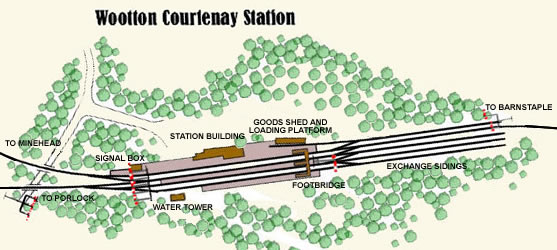

trains cross at Wootton Courtenay - photo L.T.Catchpole
Simple request halts with small concrete
shelters are provided at Brockwell Lane, Huntscott, Luccombe, Allerford
and Holnicott and Bossington Lane.
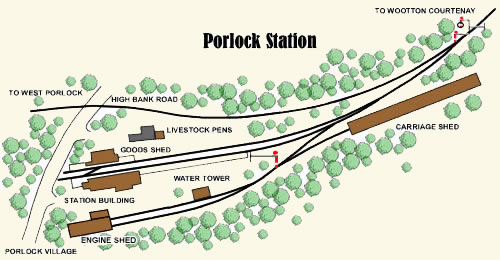
The other terminus for passenger operations
is at Porlock. It is probably over provided for in relation to traffic and
includes two fine station buildings, large engine shed and carriage shed.
The smaller of the two station buildings is now leased to a local chef who
operates a popular restaurant there. It is renowned for sea food.
These days, the passenger service is run
using a railcar that had formally run on the Barnstaple and Minehead line.
With its polished aluminium and modern lines, it cuts a dash in the area
and traffic has improved as a result.

Glenthorne's new railcar races through the countryside near Luccombe in
early spring 1935.
The goods line to West Porlock leaves the man
line some distance from the station. The condition of trackwork on this
section is visibly of a poorer quality. Staff who work at the power
station are able to unofficially hitch rides on the coal wagons. This must
be an uncomfortable and very dirty practice! It has been mooted that the
line should be extended to Porlock Weir but nothing has come of the plan
so far.

The goods line towards the power station.
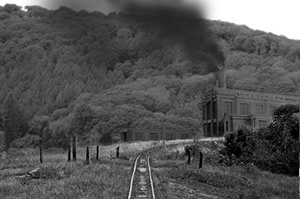
the Glenthorne Power station at West Porlock
This line has always run on 'staff and
ticket' and has no intermediate passing loops.
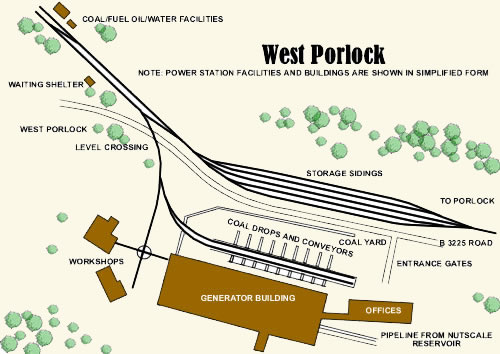

|